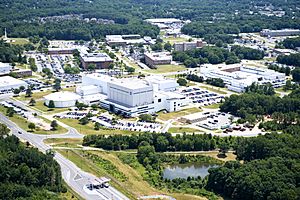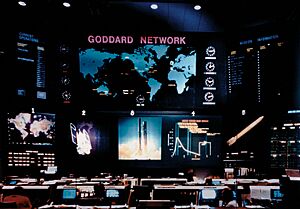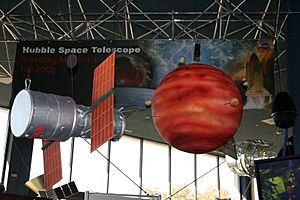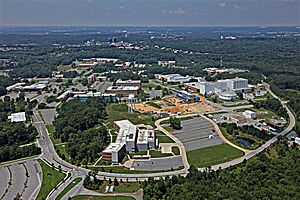Goddard Space Flight Center facts for kids
 |
|
 Aerial view of Goddard Space Flight Center (2010) |
|
| Agency overview | |
|---|---|
| Formed | May 1, 1959 |
| Preceding agency |
|
| Jurisdiction | Federal government of the United States |
| Headquarters | Greenbelt, Maryland, United States 38°59′32″N 76°51′9″W / 38.99222°N 76.85250°W |
| Employees | 10,000 civil service and contractor |
| Agency executives |
|
| Parent agency | NASA |
| Child agencies |
|
| Map | |

Goddard map
|
|
The Goddard Space Flight Center (GSFC) is a super important NASA science lab. It's located near Greenbelt, Maryland, in the United States. This center was started on May 1, 1959. It was NASA's very first space flight center!
About 10,000 people work at Goddard, including scientists and engineers. It's named after Robert H. Goddard, who was a pioneer in rocket science. Goddard is one of ten main NASA centers across the country.
GSFC has the largest group of scientists and engineers in the U.S. They all work to learn more about the Earth, our Solar System, and the whole Universe. They do this by using special tools and observations from space. Goddard is a key place for building and running uncrewed (no people on board) scientific spacecraft.
Scientists at Goddard plan and support missions. Engineers and technicians then design and build the spacecraft for these missions. For example, Goddard scientist John C. Mather won a Nobel Prize in Physics in 2006. He won it for his work on the Cosmic Background Explorer (COBE) mission.
Goddard also runs two networks that track spacecraft and collect data. These are the Space Network and the Near Earth Network. They also create and manage advanced systems for Earth and space science data. Plus, they develop satellites for the National Oceanic and Atmospheric Administration (NOAA).
Contents
Exploring Space: Goddard's Amazing Missions
Goddard manages many exciting NASA and international missions. These include the James Webb Space Telescope (JWST) and the Hubble Space Telescope (HST). They also manage programs like the Explorers Program and the Discovery Program.
Past Space Adventures
Goddard has been involved in space missions since Explorer 1. That was America's first artificial satellite! The Landsat spacecraft series has been studying Earth's resources since 1972. TIROS-1, launched in 1960, was the first successful weather satellite. The Compton Gamma Ray Observatory worked for nine years, studying gamma rays. The Cosmic Background Explorer (COBE) gave us amazing data about the early universe.
Current Space Explorations
Today, Goddard helps run many spacecraft that collect scientific data. These include Earth science projects like the Earth Observing System (EOS). EOS has satellites like Terra, Aqua, and Aura. Other important Earth projects are the Tropical Rainfall Measuring Mission (TRMM) and the Global Precipitation Measurement (GPM) mission. These help predict hurricanes. Goddard also supports the Geostationary Operational Environmental Satellite (GOES) system for weather forecasts.
Goddard also has many space science missions. The Hubble Space Telescope is one of the most famous. It has been exploring astronomy since 1990. The Wilkinson Microwave Anisotropy Probe (WMAP) studies how the universe formed. The Solar and Heliospheric Observatory (SOHO) studies the Sun. The Lunar Reconnaissance Orbiter (LRO) maps the Moon. The Solar Dynamics Observatory (SDO) tracks the Sun's energy. The OSIRIS-REx mission brought back a sample from asteroid 101955 Bennu in 2023. It's now heading to asteroid 99942 Apophis as OSIRIS-APEX.
The James Webb Space Telescope, launched in 2022, is also a big deal. It helps scientists study the first stars and galaxies.
Future Missions: What's Next?
The Goddard team is always working on new projects. These missions will launch in the coming years. They hope to uncover even more secrets about our universe.
How Goddard Studies Earth and Space
Goddard's missions help answer big science questions. These questions are about Earth, space, the Sun, and our Solar System. Basically, Goddard studies everything from our home planet to distant galaxies!
Understanding Our Earth
In Earth sciences, Goddard helps us understand our planet as a whole system. They look at how different parts of Earth work together. This helps scientists understand how human activities and natural events might affect our planet in the future.
Discovering the Universe
In space sciences, Goddard has made huge discoveries. John Mather's Nobel Prize for the COBE mission is a great example. Goddard studies how the universe began, what it's made of, and how it changes. They also research how stars and planets form. Plus, they study how the Sun affects everything around it.
From Questions to Spacecraft
New missions start with new science questions. Scientists use what they already know to ask even bigger questions. Then, they figure out what kind of data they need to collect. This leads to designing special spacecraft and scientific instruments.
Goddard's Sciences and Exploration Directorate (SED) leads these science efforts. They also develop new technology for scientific research.
Tools for Space: Scientific Instruments
Goddard develops amazing new scientific instruments. These tools help them observe things in space that have never been seen before. Often, instruments are known by their initials. For example, the James Webb Space Telescope has four main instruments: Mid-Infrared Instrument (MIRI), Near-Infrared Camera (NIRCam), Near-Infrared Spectrograph (NIRSpec), and Fine Guidance Sensor and Near Infrared Imager and Slitless Spectrograph (FGS-NIRISS). Goddard scientists and engineers work closely to build these.
Sometimes, a mission needs more than one spacecraft. The Magnetospheric Multiscale Mission (MMS) uses four spacecraft flying together. They study magnetic reconnection, a complex 3-D process. Each spacecraft has the same set of instruments.
Working Together: Science Partnerships
Goddard often works with other groups. These include government agencies, universities, and other countries. Sometimes, partners develop the instruments. Other times, Goddard builds them. All the instruments are then put together on the spacecraft.
For example, on the Lunar Reconnaissance Orbiter (LRO), Goddard developed one instrument called LOLA. LOLA helps create a 3-D map of the Moon. For the MAVEN mission to Mars, Goddard managed the project and built two magnetometers.
Storing Space Data
Once a mission is in space, its instruments collect data. This data is sent back to Earth. Goddard stores and analyzes huge amounts of scientific data from past and current missions. The Goddard Earth Science Data and Information Services Center (GES DISC) provides Earth science data to scientists and students. The NASA Space Science Data Coordinated Archive (NSSDCA) keeps a permanent record of space science data, including many images.
History of Goddard Space Flight Center
Goddard was first called the Beltsville Space Center. It was NASA's first of four space centers. Its main jobs were to develop technology, plan missions, do scientific research, run technical operations, and manage projects.
On May 1, 1959, it was renamed the Goddard Space Flight Center (GSFC). This honored Robert H. Goddard. Its first 157 employees came from the U.S. Navy's Project Vanguard missile program.
Goddard helped with Project Mercury, America's first program to send humans into space. Later, a new center, the Johnson Space Center, was built for crewed missions. Goddard then focused on designing uncrewed satellites and spacecraft for science.
Goddard helped create modular design for spacecraft. This means satellites can be repaired in orbit, saving money. The Solar Max satellite was repaired by astronauts in 1984. The Hubble Space Telescope, launched in 1990, is still working thanks to its modular design and repairs by space shuttles.
Today, Goddard is still involved in all of NASA's main programs. They have developed more instruments for planetary exploration than any other group. They also contribute to Earth science with the Earth Observing System. For crewed spaceflight, Goddard develops tools for astronauts and operates the Lunar Reconnaissance Orbiter.
Technologies That Help Earth
Goddard's work in space also helps us here on Earth! This is called "spinoff technology." NASA started a program in 1962 to make sure space technologies could be used to help the economy and improve life.
Since 1976, NASA has published a yearly report called "Spinoff" about these technologies. Goddard has made many important contributions. For example, weather balloon technology now helps firefighters with short-range radios. The special material called aluminized Mylar used in satellites makes sports equipment better insulated. Laser optics systems from space missions have improved cameras. Also, tools that look for life on other planets now help scientists find bacteria in contaminated food.
Goddard's Facilities
Goddard's campus is about 6.5 miles (10 km) northeast of Washington, D.C. It's located in Greenbelt, Maryland.
Special Testing Areas
Building 29 has the world's largest cleanroom. It's a super clean space where spacecraft parts are built. This keeps them free from dust and germs. Nearby, there are vacuum chambers that can be made very hot or very cold. This tests how spacecraft will handle extreme conditions in space. There's also a giant centrifuge that can spin things to test how they handle strong forces.
High Energy Astrophysics Science Archive Research Center
The High Energy Astrophysics Science Archive Research Center (HEASARC) is where NASA keeps data about X-ray and gamma ray astronomy. This information is available to the public and scientists.
Near Space Operations Control Center (NSOCC)
This center, in Building 13, is a key hub for managing space missions. It has supported every Space Shuttle mission. Today, the NSOCC helps with launches like SpaceX Crew & Cargo missions. It also supports science missions like JWST and PACE. It even provides data services for other space agencies like Japan's JAXA and Europe's ESA.
The NSOCC is a place where many different teams work together. They make sure that NASA and its partners get the best possible service for their missions.
Goddard Visitor Center
The Goddard Visitor Center is open to everyone, free of charge. It has cool displays of spacecraft and technologies developed at Goddard. You can see models of the Hubble Space Telescope and amazing images from space. There's also a "Science On a Sphere" system that projects images onto a giant globe.
The center also has resources for teachers and hosts special events. For example, in 2008, they had Goddard LaunchFest with robot competitions and tours.
Other Goddard Locations
Goddard also runs three other important facilities:
- The Wallops Flight Facility in Wallops Island, Virginia. This is one of the oldest launch sites in the world. It manages NASA's sounding rocket program, launching about 35 missions each year.
- The Goddard Institute for Space Studies (GISS) in New York City. Here, scientists do a lot of theoretical research in space science and Earth science.
- The Katherine Johnson Independent Verification and Validation Facility (IV&V) in Fairmont, West Virginia. This facility works to make sure software used in NASA missions is safe and reliable.
Goddard's Team
Goddard Space Flight Center has over 3,000 employees who work directly for the government. About 60% of them are engineers and scientists. Plus, about 7,000 contractors work there every day. It's one of the biggest groups of space scientists and engineers in the world!
Students from universities across the U.S. can also work at Goddard through internship programs. These programs give students a chance to learn and work on challenging science and engineering projects.
Community Connections
Goddard connects with local communities through volunteer and education programs. Employees are encouraged to mentor students and speak at schools. Goddard also hosts public talks about engineering, leadership, and science. You can sign up in advance to get a visitor's pass to attend these events.
Queen Elizabeth II's Visit
Queen Elizabeth II of the United Kingdom and her husband Prince Philip, Duke of Edinburgh visited Goddard Space Flight Center on May 8, 2007. The Queen even spoke with the crew aboard the International Space Station from the Network Integration Center (now NSOCC).
Panorama
See also
 In Spanish: Centro de Vuelo Espacial Goddard para niños
In Spanish: Centro de Vuelo Espacial Goddard para niños
- Goddard Earth Observing System
- Marshall Space Flight Center
- Jet Propulsion Laboratory









